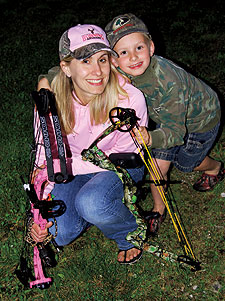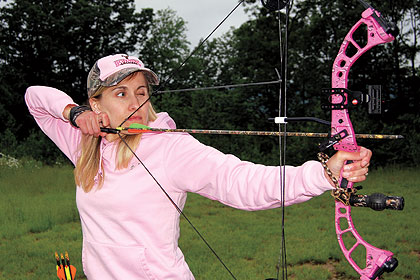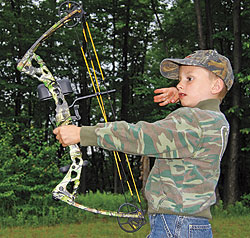October 28, 2010
By Christian Berg
Expert advice for sharing your archery addiction.
By Christian Berg
 Introducing spouses and children to archery can be a rewarding or frustrating experience, depending on how you approach it. Make an extra effort to ensure their first shooting experience is a positive one. |
There's a good reason bow and arrow shooting has universal appeal.
"You don't have to be tall, strong, fast or pretty to have success in archery," said Roy Grimes, president of the non-profit National Archery in the Schools Program.
Advertisement
In other words, virtually anyone can do it. And when properly outfitted and trained, men, women, youth and even disabled shooters can compete side by side on equal footing.
When it comes to spreading that message and growing the sport, no organization is accomplishing more than NASP. Since its inception in Kentucky in 2002, NASP has expanded to more than 5,000 schools in 46 states, three Canadian provinces, Australia, New Zealand and South Africa.
Advertisement
"We had no idea it would work so well," said Grimes, adding that 4.6 million children have gone through the two-week NASP training program, which is offered to students in grades four through 12.
Perhaps even more impressive are NASP survey results showing that while 77 percent of NASP participants had never shot a bow before, 21 percent of students who complete the program purchase their own archery equipment within a year.
"Those are [new] archers," Grimes said.
Considering NASP's success, the program is a perfect model for bowhunters who want to share the archery addiction with their children, spouses or significant others. We sought some expert advice from former professional shooter and U.S. Olympic coach Tim Strickland, who wrote NASP's instructional curriculum.
 When introducing new people to archery, make sure their equipment is properly fitted. Many manufacturers now also offer stylish women's bows such as this pink PSE Chaos. If a pink bow will pique your wife's interest in shooting, by all means forego the camouflage. |
Strickland, host of New Age Archery on The Sportsman Channel, has 10 national bull's-eye shooting titles to his credit and also coached the 1996 U.S. men's Olympic archery team that won gold at the Atlanta Games. Here's Strickland's advice for starting your family's archery adventure on solid footing:
Be Realistic
Turning your kids into miniature bowhunters will not happen overnight. And if you think your sweet baby is going to get up at the crack of dawn and climb into a freezing cold treestand next to you, well, let's just say you very likely have another thing coming.
Yes, some spouses and kids will certainly follow your footsteps into the field. And if you're really lucky, they'll develop a passion for bowhunting that at least remotely resembles yours. But you know what? It's OK if that doesn't happen. Even if your family's archery togetherness never moves beyond flinging arrows at a backyard bag target, or participating in weekend 3-D shoots at the local archery club, you should still consider that a huge success, because you've introduced them to an exciting sport they can enjoy throughout their lives.
"When you are coaching someone or trying to influence someone, you want to do it in a positive fashion," Strickland said. "You always want to base the expectations on what the person you are dealing with wants to do -- and keep how you feel and how you want them to do out of it. All of it is a process that takes time and application."
Fun And Fundamentals
Especially when dealing with children, organized activities need to be fun. Make early shooting sessions tedious and you risk losing them for good.
"With some people, if you keep teaching them, they don't really want to be there after a while," Strickland said. "You just see what a kid wants to do and how much they want to learn. It's totally individual, and you want to err on the ending early side of the losing interest thing."
Some days, my boys (ages 5 and 3) might only want to shoot six, nine or a dozen arrows in a session. You know what? That's great! Let them shoot for 10 minutes and go. First of all, that leaves them with a positive archery experience they'll want to come back to again (instead of a drudgery they have to endure until I'm satisfied). And secondly, once the junior varsity practice is over, I've got all the time (and quiet) needed to work on my own form and really tune my mental focus for the hunting seasons ahead.
 Kids don't have a long attention span, so spend the limited shooting time you have with them stressing fundamentals such as proper form and follow-through. |
As for pressure, Strickland said simply putting a bow into the hands of a new shooter can be more pressure than necessary. The reason, he explained, is that new shooters -- whether it's a 5-year-old boy or 50-year-old wife -- can't help but judge their initial efforts based on where the arrow hits (or doesn't hit) the target.
"That's the reason we have the terrible issue of drop-out in archery, because you shoot it, and then you locate where you shot and decide whether that is good or bad," Strickland said. "It's all important to focus on the principle of shooting -- not the end result.
"It's absolutely no different than learning how to walk. When you learned how to walk, you didn't stop after every step and think, 'Now, was my foot right?' It's all the principle of the technique, and the better the technique is, the better the outcome." Toward the end, Strickland recommends starting new shooters with a "string bow," which is nothing more than a loop of string held in the bow hand and drawn with the shooting hand. By employing a string bow, Strickland said you can teach every aspect of proper shooting form without any pressure to perform.
"You can cover every fundamental with a string bow," Strickland said. "They teach kids how to shoot, and the muscles to use and the principles, before they ever touch a bow."
Proper Fit
And Patience
Once you've covered the fundamentals, it's time for the actual shooting to begin.
Although Strickland said it doesn't really matter whether a new shooter begins with traditional or compound bows, it is critical that whatever equipment is chosen be properly fit.
"The last thing you ever, ever do is get somebody overbowed," Strickland said. "You can start a young person and overbow them to the point where they will literally set up in their mind an issue that is a detriment to them, and it may be with them their whole life.
If they have to struggle at all to get over the peak with a compound bow, or with a traditional bow to hold it at full draw, then the bow is too heavy."
Strickland also recommends starting newcomers -- particularly children -- as finger shooters. "I think it is an extremely bad idea to start a young person with a release aid, because there's a temptation to anticipate the shot and not make back tension trigger it," he said. "With your fingers, it's a little different deal. Basically, what you are doing with your fingers is loosing the tension. You don't have to worry about letting go of the string.
If you release all the tension in your fingers, I'll guarantee you the string will leave."
As for the shooting itself, you can't expect bull's-eyes -- or at least consistent accuracy -- right away. You shouldn't even expect proper form or a basic understanding of equipment. That's where patience comes into play. My 5-year-old needs to be reminded about proper foot spacing and body orientation before nearly every shot.
With my wife, it's much easier to give directions. For one, she can understand what I'm telling her much better, and for another, she also has a competitive streak. So, when I tell her to relax her grip on the riser, make sure she uses a consistent anchor point or hold the bow steady through the release, she's much more likely to listen, because she wants her arrow to go where she's aiming.
Generally speaking, just focus on instilling good fundamentals and don't worry about whether the arrows are striking the 12-ring. To ensure new shooters experience some immediate "success," Grimes recommends starting off with a blank target face and positioning shooters just five to seven yards away.
Finally, keep in mind that each shooter will progress at his or her own pace. "Shooting an arrow and shooting well is not that difficult," Strickland said. "It [becomes] difficult because of the way a person perceives it and approaches it."
